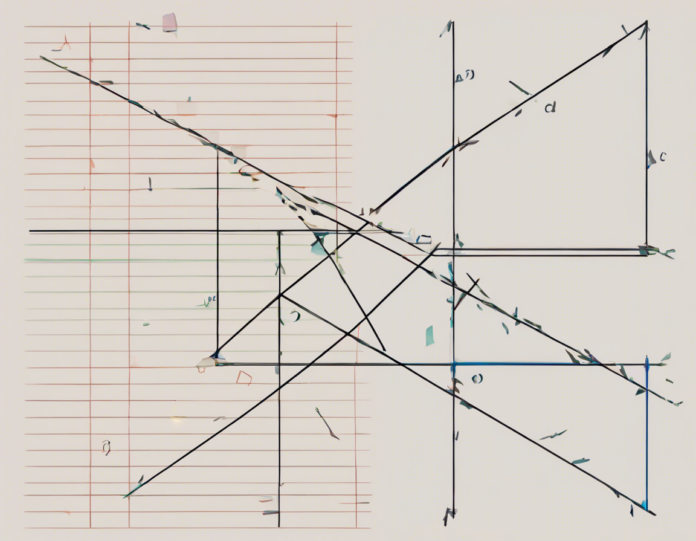Rectangles are one of the most common geometric shapes encountered in everyday life, from the screens of our electronic devices to the walls of our homes. One of the most intriguing and visually appealing properties of a rectangle is perfect symmetry, particularly when it comes to its diagonals. Understanding the concept of equal diagonals in a rectangle can unveil a fascinating aspect of geometry that extends beyond mere calculations and into the realm of aesthetic harmony.
The Anatomy of a Rectangle:
Before delving into the symmetrical allure of equal diagonals, let's take a close look at the fundamental characteristics of a rectangle. A rectangle is a quadrilateral with four right angles, where opposite sides are equal in length. This unique combination of attributes gives rise to several interesting properties that distinguish rectangles from other geometric shapes.
Properties of a Rectangle:
-
Opposite sides are equal: In a rectangle, the opposite sides are always of equal length. This property is what sets rectangles apart from other quadrilaterals.
-
Angles are right angles: All four angles in a rectangle are right angles (90 degrees), providing stability and structure to the shape.
-
Diagonals bisect each other: The diagonals of a rectangle intersect each other at their midpoints, dividing each other into two equal segments.
Equal Diagonals: The Symmetry Within:
The most captivating aspect of a rectangle lies in its diagonals. Unlike other quadrilaterals, a rectangle possesses diagonals that are not only equal in length but also intersect each other at the midpoint, forming four right triangles of equal size. This inherent symmetry within a rectangle is what makes it visually appealing and mathematically intriguing.
Understanding Diagonal Length in a Rectangle:
-
Equal Diagonal Length: The diagonals of a rectangle are always equal in length. This unique property is a direct result of the rectangle's symmetrical nature, where opposite sides are equal, and the diagonals intersect at right angles.
-
Diagonal Formula: The length of the diagonals in a rectangle can be calculated using the Pythagorean theorem. If the length of the sides of the rectangle is given as a and b, then the length of the diagonals (d) can be calculated as:
-
d = √(a^2 + b^2)
-
Proof of Equal Diagonals: To understand why the diagonals in a rectangle are equal, we can divide the rectangle into two right triangles using one diagonal as the hypotenuse. By applying the Pythagorean theorem to both triangles, we can demonstrate that the lengths of the diagonals are indeed equal.
Visualizing Symmetry:
Imagine a rectangular picture frame hanging on a wall or a sleek tablet with a rectangular screen. The perfect symmetry of equal diagonals in a rectangle is not only a geometric principle but also a visual harmony that appeals to our sense of balance and proportion. Whether in architecture, design, or mathematics, the concept of equal diagonals in a rectangle underscores the beauty of symmetry in our surroundings.
Applications of Equal Diagonals:
-
Architectural Design: Architects often use rectangles and squares as foundational shapes in building design. The equal diagonals in a rectangle ensure structural stability and visual balance in architectural masterpieces.
-
Art and Photography: Artists and photographers utilize the symmetry of rectangles to create visually pleasing compositions. The equal diagonals contribute to the balance and harmony of artistic expressions.
-
Engineering and Construction: Engineers rely on the principles of equal diagonals in rectangles to ensure the stability and strength of structures, from bridges to skyscrapers.
Frequently Asked Questions (FAQs):
- Are the diagonals in a rectangle always equal in length?
-
Yes, the diagonals in a rectangle are always equal in length due to the symmetrical nature of the shape.
-
How do equal diagonals affect the stability of a rectangle?
-
Equal diagonals contribute to the stability of a rectangle by distributing forces evenly across the shape, minimizing potential deformation.
-
Can a square be considered a special case of a rectangle with equal diagonals?
-
Yes, a square is a special type of rectangle where all sides are equal in length, resulting in diagonals that are also equal.
-
Does the concept of equal diagonals apply to non-rectangular quadrilaterals?
-
No, equal diagonals are a unique property of rectangles and squares due to their specific geometric attributes.
-
How is the Pythagorean theorem used to calculate diagonal length in a rectangle?
- The Pythagorean theorem is applied to the right triangles formed by a diagonal in a rectangle to determine the length of the diagonals.
In conclusion, the concept of equal diagonals in a rectangle goes beyond mathematical precision; it embodies a sense of balance, symmetry, and harmony that transcends the confines of geometry. From the structural integrity of architectural wonders to the aesthetic appeal of art and design, equal diagonals in a rectangle serve as a visual reminder of the inherent beauty and order in the world around us. Whether you're admiring a piece of art or contemplating the design of a building, the perfect symmetry of equal diagonals in a rectangle invites us to appreciate the elegance of geometric principles woven into the fabric of our everyday experiences.
